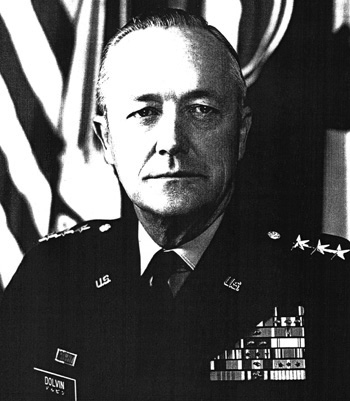
|
Welborn G. Dolvin, Sr. |
 |
|||
| Rank, Service | ||||
Lieutenant General O-9, U.S. Army |
||||
| Veteran of: | ||||
|
||||
| Tribute: | ||||
Tom Dolvin was born on February 8, 1916, in Siloam, Georgia. He attended the Citadel in Charleston, South Carolina, before entering the U.S. Military Academy at West Point on July 1, 1935, and graduated with a commission as a 2d Lt of Infantry on June 12, 1939. Lt Dolvin first served with the 29th and 67th Infantry Regiments before transferring to the Calvary, where he first served as commander of Headquarters Company, 756th Tank Battalion at Fort Lewis, Washington, from June 1941 to August 1942, and then as Battalion S-2 and S-3 of the 756th at Camp Pickett, Virginia, from August to December 1942. Capt Dolvin then deployed with the unit to North Africa, where he served as Battalion S-2 and S-3 until May 1943, and then as Executive Officer until July 1944, when he was promoted to LtCol and made commander of the 191st Tank Battalion. Col Dolvin led the 191st in the invasion of Southern France in August 1944 and throughout the rest of the war in Europe as it drove all the way into Germany. He returned to the U.S. in February 1946, and after completing the Instructor Training Officer Course at Fort Knox, Kentucky, he served as an instructor and Chief of the Armored Group in the Tactical Section of the Army Infantry School at Fort Benning, Georgia, from March 1946 to August 1949. Col Dolvin attended Command and General Staff School at Fort Leavenworth, Kansas, from September 1949 to July 1950, and then took command of the 8072nd Medium Tank Battalion, which was replaced by the 89th Medium Tank Battalion in Korea in August 1950. He led the 89th in combat in Korea until June 1951, when he was made Deputy Chief of Staff and then Chief of Staff of the 25th Infantry Division in Korea, serving until October 1951. His next assignment was as a staff officer with the Office of the Chief of Research and Development, Headquarters U.S. Army, in the Pentagon from October 1951 to August 1953. Col Dolvin attended Army War College at Carlisle Barracks, Pennsylvania, from August 1953 to July 1954, and then served on the staff and later as director of the Armored School at Fort Knox from July 1954 to May 1956. He returned to the Office of the Chief of Research and Development in the Pentagon from June 1956 to June 1959, and then served as commander of Combat Command A of the 4th Armored Division in Europe from June 1959 to May 1961. Gen Dolvin next served as Assistant Chief of Staff for Plans and Operations with Allied Land Forces Central Europe with NATO from May 1961 to May 1963, followed by service as program manager for the Tank Development Program at Fort Knox and at the Pentagon from May 1963 to October 1966. His next assignment was as Commanding General of the 3rd Armored Division in Europe from October 1966 to May 1968, and then as Chief of Staff of Central Army Group with NATO from May 1968 to January 1970. He served as Special Assistant to the Commander of the U.S. Military Assistance Command in the Republic of Vietnam from January to March 1970, followed by service as Chief of Staff of U.S. Military Assistance Command, Vietnam, from March 1970 to May 1971. Gen Dolvin next served as Commanding General of XXIV Corps in Vietnam from June 1971 to March 1972, and then as Commanding General of IX Corps in Japan from May 1972 until his retirement from the Army on March 1, 1975. After retiring from the Army, he served as the Department of Defense Representative to the Panama Canal Treaty Negotiations from 1975 to 1982, and also as the Chairman of the Joint Chiefs of Staff Representative to the Mutual Balanced Force Reduction Negotiations, from 1980 to 1982. Tom Dolvin died on May 17, 1991, and was buried at Arlington National Cemetery. |
||||
|
||||

